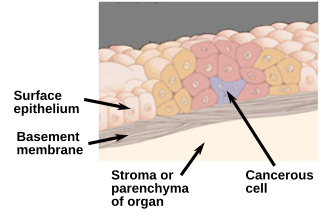Related Research Articles

Carcinoma in situ (CIS) is a group of abnormal cells. While they are a form of neoplasm, there is disagreement over whether CIS should be classified as cancer. This controversy also depends on the exact CIS in question. Some authors do not classify them as cancer, however, recognizing that they can potentially become cancer. Others classify certain types as a non-invasive form of cancer. The term "pre-cancer" has also been used.

Clear cell ovarian carcinoma is one of several subtypes of ovarian carcinoma. Clear cell is a subtype of epithelial ovarian cancer in contrast to non-epithelial cancers. According to research, most ovarian cancers start at the epithelial layer which is the lining of the ovary. Within this epithelial group clear cell ovarian carcinoma makes up about 5-10%.

A neoplasm is a type of abnormal and excessive growth of tissue. The process that occurs to form or produce a neoplasm is called neoplasia. The growth of a neoplasm is uncoordinated with that of the normal surrounding tissue, and persists in growing abnormally, even if the original trigger is removed. This abnormal growth usually forms a mass, when it may be called a tumor.

Cancer research is research into cancer to identify causes and develop strategies for prevention, diagnosis, treatment, and cure.

A benign tumor is a mass of cells (tumor) that lacks the ability either to invade neighboring tissue or metastasize. When removed, benign tumors usually do not grow back, whereas malignant tumors are cancerous and sometimes do. Unlike most benign tumors elsewhere in the body, benign brain tumors can be life-threatening. Benign tumors generally have a slower growth rate than malignant tumors and the tumor cells are usually more differentiated. They are typically surrounded by an outer surface or stay contained within the epithelium. Common examples of benign tumors include moles and uterine fibroids.
Initiation factors are proteins that bind to the small subunit of the ribosome during the initiation of translation, a part of protein biosynthesis.

Eukaryotic translation initiation factor 5A-2 is a protein that in humans is encoded by the EIF5A2 gene.
Progression-free survival (PFS) is "the length of time during and after the treatment of a disease, such as cancer, that a patient lives with the disease but it does not get worse". In oncology, PFS usually refers to situations in which a tumor is present, as demonstrated by laboratory testing, radiologic testing, or clinically. Similarly, "disease-free survival" is the length of time after patients have received treatment and have no detectable disease.
Tumor promotion is a process in carcinogenesis by which various factors permit the descendants of a single initiated cell to survive and expand in number, i.e. to resist apoptosis and to undergo clonal growth. This is a step toward tumor progression.
Somatic evolution is the accumulation of mutations and epimutations in somatic cells during a lifetime, and the effects of those mutations and epimutations on the fitness of those cells. This evolutionary process has first been shown by the studies of Bert Vogelstein in colon cancer. Somatic evolution is important in the process of aging as well as the development of some diseases, including cancer.

Tumor progression is the third and last phase in tumor development. This phase is characterised by increased growth speed and invasiveness of the tumor cells. As a result of the progression, phenotypical changes occur and the tumor becomes more aggressive and acquires greater malignant potential. Together with the progression, more and more aneuploidy occurs. This may be evident as nuclear polymorphism.
Gopal Chandra Kundu is an renowned Indian cell and cancer biologist and a Senior Scientist (Scientist-G) at National Centre for Cell Science. He is known for his contributions towards the understanding the mechanism of cancer progression in breast, melanoma and other cancers and development of novel therapeutic targets and target-based therapy in cancers.

Palbociclib, sold under the brand name Ibrance among others, is a medication developed by Pfizer for the treatment of HR-positive and HER2-negative breast cancer. It is a selective inhibitor of the cyclin-dependent kinases CDK4 and CDK6. Palbociclib was the first CDK4/6 inhibitor to be approved as a cancer therapy.

Suresh H. Moolgavkar M.D., Ph.D. is a mathematician and epidemiologist at the University of Washington and the Fred Hutchinson Cancer Research Center in Seattle. Among his many scientific contributions is the development of the two-stage clonal expansion (TSCE) model of carcinogenesis, also known as the Moolgavkar-Venzon-Knudson (MVK) model, a stochastic cell-level description of carcinogenesis based on Alfred G. Knudson’s two-hit hypothesis. In its original development the TSCE model represents tumor initiation as the first hit, followed by cell proliferation and malignant transformation as the second hit. It has been interpreted as describing the initiation-promotion-progression sequence observed in chemical carcinogenesis and has been applied widely for the analysis of both experimental and epidemiological data for purposes of quantitative risk assessment.

Antonius Jozef Maria "Anton" Berns is a Dutch scientist researching molecular genetics and author of the Mouse Cancer Models studies series.

Durvalumab is an FDA-approved immunotherapy for cancer, developed by Medimmune/AstraZeneca. It is a human immunoglobulin G1 kappa (IgG1κ) monoclonal antibody that blocks the interaction of programmed cell death ligand 1 (PD-L1) with the PD-1 (CD279).

Allan Balmain FRS FRSE is Barbara Bass Bakar Distinguished Professor of Cancer Genetics at the University of California, San Francisco (UCSF).
Cancer selection can be viewed through the lens of natural selection. The animal host's body is the environment which applies the selective pressures upon cancer cells. The most fit cancer cells will have traits that will allow them to out compete other cancer cells which they are related to, but are genetically different from. This genetic diversity of cells within a tumor gives cancer an evolutionary advantage over the host's ability to inhibit and destroy tumors. Therefore, other selective pressures such as clinical treatments and pharmaceutical treatments are needed to help destroy the large amount of genetically diverse cancerous cells within a tumor. It is because of the high genetic diversity between cancer cells within a tumor that makes cancer a formidable foe for the survival of animal hosts. It has also been proposed that cancer selection is a selective force that has driven the evolution of animals. Therefore, cancer and animals have been paired as competitors in co-evolution throughout time.

Ripretinib, sold under the brand name Qinlock, is a medication for the treatment of adults with advanced gastrointestinal stromal tumor (GIST), a type of tumor that originates in the gastrointestinal tract. It is taken by mouth. Ripretinib inhibits the activity of the kinases KIT and PDGFRA, which helps keep cancer cells from growing.

Lurbinectedin, sold under the brand name Zepzelca, is a medication used for the treatment of small cell lung cancer.
References
- ↑ "tumor initiation". National Cancer Institute. Retrieved 9 Nov 2012.
- ↑ Compton C (2020). "Cancer initiation, promotion, and progression and the acquisition of key behavioral traits.". Cancer: The Enemy from Within. Cham: Springer. pp. 25–48. doi:10.1007/978-3-030-40651-6_2.
![]() This article incorporates public domain material from the U.S. National Cancer Institute document: "Dictionary of Cancer Terms".
This article incorporates public domain material from the U.S. National Cancer Institute document: "Dictionary of Cancer Terms".